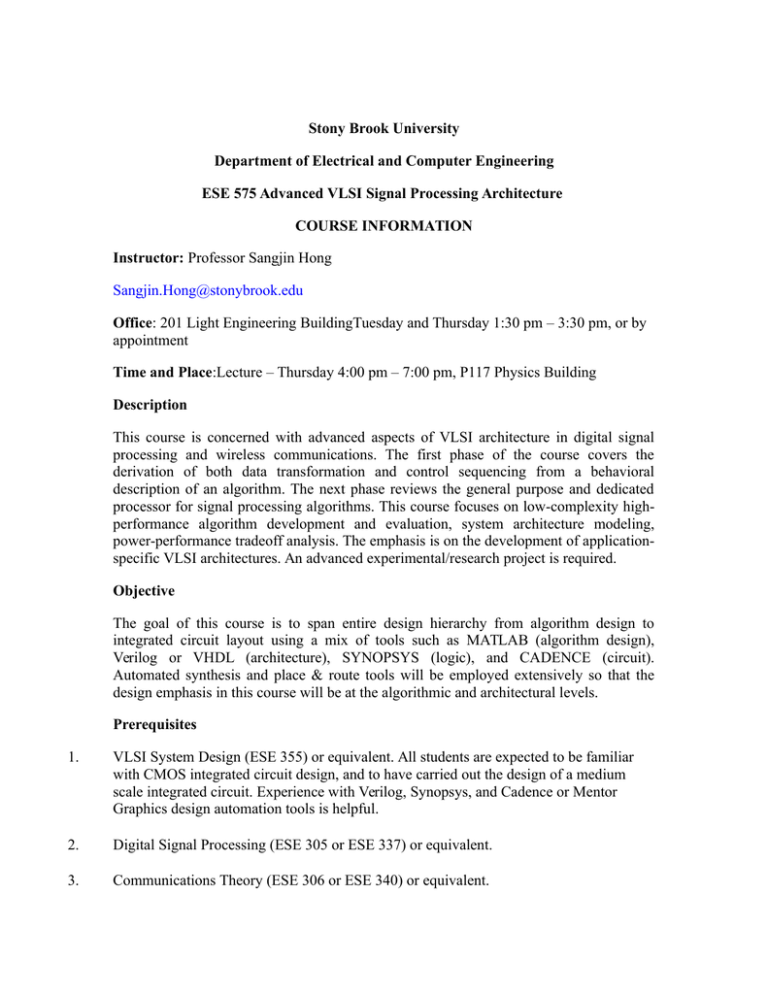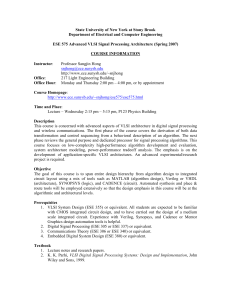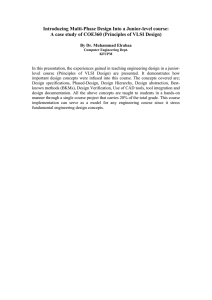ESE 575 - Advanced VLSI Signal Processing Architecture
advertisement

Stony Brook University Department of Electrical and Computer Engineering ESE 575 Advanced VLSI Signal Processing Architecture COURSE INFORMATION Instructor: Professor Sangjin Hong Sangjin.Hong@stonybrook.edu Office: 201 Light Engineering BuildingTuesday and Thursday 1:30 pm – 3:30 pm, or by appointment Time and Place:Lecture – Thursday 4:00 pm – 7:00 pm, P117 Physics Building Description This course is concerned with advanced aspects of VLSI architecture in digital signal processing and wireless communications. The first phase of the course covers the derivation of both data transformation and control sequencing from a behavioral description of an algorithm. The next phase reviews the general purpose and dedicated processor for signal processing algorithms. This course focuses on low-complexity highperformance algorithm development and evaluation, system architecture modeling, power-performance tradeoff analysis. The emphasis is on the development of applicationspecific VLSI architectures. An advanced experimental/research project is required. Objective The goal of this course is to span entire design hierarchy from algorithm design to integrated circuit layout using a mix of tools such as MATLAB (algorithm design), Verilog or VHDL (architecture), SYNOPSYS (logic), and CADENCE (circuit). Automated synthesis and place & route tools will be employed extensively so that the design emphasis in this course will be at the algorithmic and architectural levels. Prerequisites 1. VLSI System Design (ESE 355) or equivalent. All students are expected to be familiar with CMOS integrated circuit design, and to have carried out the design of a medium scale integrated circuit. Experience with Verilog, Synopsys, and Cadence or Mentor Graphics design automation tools is helpful. 2. Digital Signal Processing (ESE 305 or ESE 337) or equivalent. 3. Communications Theory (ESE 306 or ESE 340) or equivalent. 4. Embedded Digital System Design (ESE 380) or equivalent. Textbook 1. K. K. Parhi, VLSI Digital Signal Processing Systems: Design and Implementation, John Wiley and Sons, 1999. List of Topics 1. DSP Algorithm Design - DSP representations (data-flow, control-flow, and signal-flow graphs, block diagrams), fixed-point DSP design (A/D precision, coefficient quantization, round-off and scaling), filter structures (recursive, non-recursive and lattice), algorithmic simulations of DSP systems in C and MATLAB, behavioral modeling in VHDL. System modeling and performance measures. 2. Circuits and DSP Architecture Design - Fast filtering algorithms (Winograd's, FFT, shortlength FIR), retiming and pipelining, block processing, folding, distributed arithmetic architectures, VLSI performance measures (area, power, and speed), structural modeling in VHDL. Analog signal processing for fast operation. Impact of non-ideal characteristics of analog functional blocks on the system performance. 3. DSP Module Synthesis – High performance arithmetic unit architectures (adders, multipliers, dividers), bit-parallel, bit-serial, digit-serial, carry-save architectures, redundant number system, modeling for synthesis in VHDL, synthesis via SYNOPSYS, place-and-route via CADENCE. Homework, Exams and Grading VLSI Signal Processing System design cannot be mastered without experience, so the lectures in this course are all related to the term project. All projects (basic and advanced) will include design reviews, a comprehensive written report and a final oral presentation. Written and oral reports will be graded on writing and presentation quality as well as technical content. It is imperative that students begin work on the advanced project at the beginning of the term in order to complete it. Two midterm exams; the final written reports will take the place of a final exam. Grading will be as follows: Midterms: 40% ;Advanced Project: 40% ; Homework 20% Learning Objectives At the end of this course, students will: 1. Understand the dataflow representation of the signal processing systems 2. Understand the advanced architecture of VLSI signal processing systems 3. Understand the optimization process for low power and complexity Blackboard You can access class information on-line at: http://blackboard.stonybrook.edu For help see: http://it.stonybrook.edu/services/blackboard For problems logging in, go to the helpdesk in the Main Library SINC Site or the Union SINC Site; you can also call: 631-632-9602 or e-mail: helpme@stonybrook.edu ADA Statement (Americans with Disabilities Act) If you have a physical, psychological, medical or learning disability that may impact your course work, please contact Disability Support Services, 128 ECC Building (631) 6326748. They will determine with you what accommodations are necessary and appropriate. All information and documentation is confidential. Students who require assistance during emergency evacuation are encouraged to discuss their needs with their professors and Disability Support Services. For procedures and information go to the following website: www.ehs.sunysb.edu and search Fire Safety and Evacuation and Disabilities. Academic Honesty and Integrity Each student must pursue his or her academic goals honestly and be personally accountable for all submitted work. Representing another person's work as your own is always wrong. Any suspected instance of academic dishonesty will be reported to the Academic Judiciary. For more comprehensive information on academic integrity, including categories of academic dishonesty, please refer to the academic judiciary website at www.stonybrook.edu/uaa/academicjudiciary.


